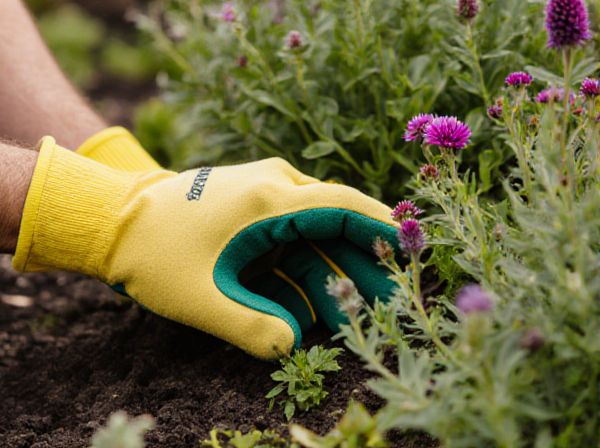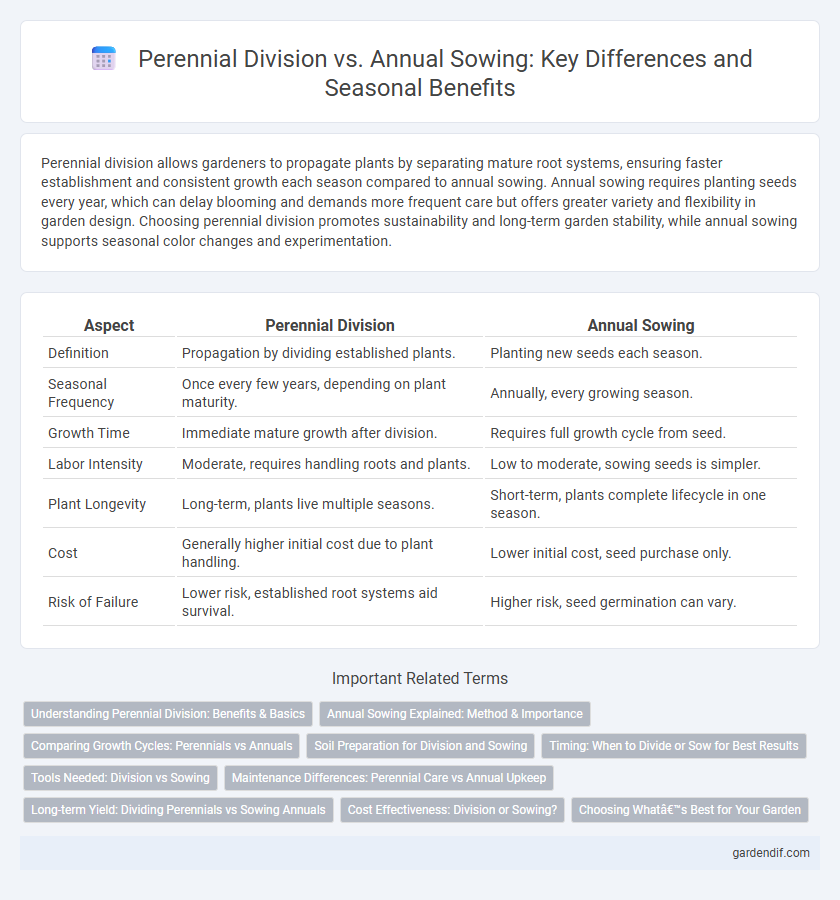
Perennial division vs Annual sowing Illustration
Perennial division allows gardeners to propagate plants by separating mature root systems, ensuring faster establishment and consistent growth each season compared to annual sowing. Annual sowing requires planting seeds every year, which can delay blooming and demands more frequent care but offers greater variety and flexibility in garden design. Choosing perennial division promotes sustainability and long-term garden stability, while annual sowing supports seasonal color changes and experimentation.
Table of Comparison
| Aspect | Perennial Division | Annual Sowing |
|---|---|---|
| Definition | Propagation by dividing established plants. | Planting new seeds each season. |
| Seasonal Frequency | Once every few years, depending on plant maturity. | Annually, every growing season. |
| Growth Time | Immediate mature growth after division. | Requires full growth cycle from seed. |
| Labor Intensity | Moderate, requires handling roots and plants. | Low to moderate, sowing seeds is simpler. |
| Plant Longevity | Long-term, plants live multiple seasons. | Short-term, plants complete lifecycle in one season. |
| Cost | Generally higher initial cost due to plant handling. | Lower initial cost, seed purchase only. |
| Risk of Failure | Lower risk, established root systems aid survival. | Higher risk, seed germination can vary. |
Understanding Perennial Division: Benefits & Basics
Perennial division is a propagation technique that involves separating established plants to promote healthier growth and extend their lifespan, ensuring year-round garden vitality. This method reduces the need for annual sowing by maintaining mature root systems, resulting in faster establishment and increased resilience against seasonal stress. Dividing perennials also enhances flowering potential, increases plant density, and helps control plant size, making it a sustainable choice for long-term garden management.
Annual Sowing Explained: Method & Importance
Annual sowing involves planting seeds each year, ensuring fresh, vigorous crops tailored to seasonal conditions. This method allows for crop rotation, reducing soil depletion and controlling pests and diseases effectively. The practice supports adaptability to changing climates and market demands, making it essential for sustainable agricultural productivity.
Comparing Growth Cycles: Perennials vs Annuals
Perennial plants exhibit multi-year growth cycles, regenerating foliage and blooms each season without replanting, which enhances long-term landscape stability and reduces maintenance. In contrast, annual plants complete their life cycle within a single growing season, requiring sowing, growth, flowering, and seed production before dying off, making them ideal for rapid seasonal color changes. Understanding these growth cycle differences informs optimal planting strategies for sustainable garden design and resource management.
Soil Preparation for Division and Sowing
Soil preparation for perennial division requires well-drained, fertile soil enriched with organic matter to support root establishment and encourage vigorous growth. Annual sowing demands finely tilled soil with a loose top layer to ensure proper seed-to-soil contact, promoting uniform germination and early root development. Maintaining optimal soil moisture levels during both methods enhances nutrient uptake and plant resilience throughout the growing season.
Timing: When to Divide or Sow for Best Results
Perennial division is best done in early spring or late fall when plants are dormant, ensuring minimal stress and optimal root establishment. Annual sowing requires precise timing in spring after the last frost to maximize germination and growth potential. Proper timing enhances plant health and yield in both perennial and annual gardening practices.
Tools Needed: Division vs Sowing
Perennial division requires garden tools such as sharp spades, digging forks, and pruning shears to carefully separate root clumps without damaging the plant, ensuring successful propagation. Annual sowing relies on seed trays, dibbers, and fine soil sieves to create optimal conditions for seed germination and early seedling growth. Each method demands specific equipment tailored to the plant's growth cycle, influencing the efficiency and outcome of propagation.
Maintenance Differences: Perennial Care vs Annual Upkeep
Perennial plants require less frequent maintenance due to their ability to survive multiple seasons, with key tasks including periodic pruning, mulching, and monitoring for pests annually. Annual plants demand more intensive upkeep, involving regular sowing, frequent watering, and ongoing fertilization throughout their single growing season. These maintenance differences directly impact gardening schedules and resource allocation, with perennials offering a long-term, low-maintenance option compared to the high routine care of annuals.
Long-term Yield: Dividing Perennials vs Sowing Annuals
Perennial division promotes long-term yield stability by enabling established root systems to recover and produce robust crops over multiple seasons, reducing replanting frequency and soil disturbance. In contrast, annual sowing requires yearly seed planting, resulting in fluctuating yields and increased labor costs but allows for crop rotation and pest management variety. Optimizing long-term productivity often favors perennial division for sustained biomass and soil health benefits.
Cost Effectiveness: Division or Sowing?
Perennial division offers cost effectiveness by reducing the need for annual seed purchases and ensuring faster plant establishment, which lowers labor costs over time. Annual sowing demands yearly seed investments and higher labor input for planting and maintenance, increasing overall expenses. Dividing perennials optimizes resource use and provides sustainable growth, making it more economical in the long term compared to annual sowing.
Choosing What’s Best for Your Garden
Perennial division involves transplanting established plants with mature root systems, promoting faster growth and long-term garden stability, while annual sowing relies on planting seeds each season, offering flexibility and variety but requiring more frequent renewal. Selecting between these methods depends on your garden's climate resilience, maintenance capacity, and desired plant longevity. Prioritize perennials for sustainable landscaping and annuals for seasonal color diversity and rapid garden transformation.
Perennial division vs Annual sowing Infographic

 gardendif.com
gardendif.com